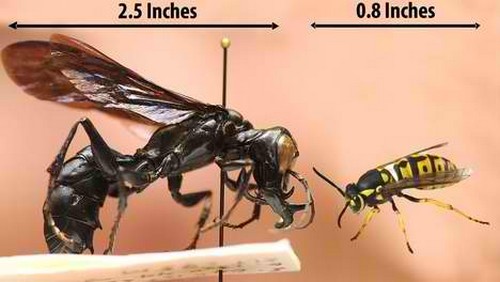Rio Tinto may get stung in Sulawesi
Published by MAC on 2011-09-19Source: Jakarta Globe, Mining.com
...and pinched in Queensland
A giant black wasp has been identified as a new species, recently discovered in the Mekongga Mountains of Southeast Sulawesi. (The report below mistakenly describes the mountain range as being in Southwest Sulawesi).
One of the problems faced by this mammoth hymenoptera larrimae is the prospect that Rio Tinto will mine huge tonnages of nickel from its habitat.
The UK-Australian mega-miner will doubtless propose establishing a biosphere reserve in the area, to mitigate any damage its mining will cause.
However, the warrior wasp is far from being the only endemic species threatened by mining in Sulawesi. Nor is this the only region where non-human creatures are potentially affected by Rio Tinto's plans.
The company may also soon be locking pincers with crabs close to its Weipa bauxite mine in the Australian state of Queensland. Or, at any rate, having to take on environmentalists who are siding with the crustaceans.
New Wasp Species Discovered in Indonesia Shocks Scientists
Lydia Tomkiw
Jakarta Globe
1 September 2011
An American scientist working with a team of Indonesians scientists has discovered a new giant black warrior wasp species. The wasp will be added to the list of items named after the country's national symbol, the mythical bird Garuda.
 |
| Warrior wasp is up against Rio Tinto |
The insect-eating predator was discovered by Lynn S. Kimsey, a professor of entomology and the director of the Bohart Museum of Entomology at the University of California, Davis, while working with 12 scientists from the Indonesian Institute of Sciences (LIPI) during an expedition to the Mekongga Mountains of Sulawesi.
Scientists are shocked by the discovery of the insect, with the male wasp measuring approximately two-and-a-half inches long. Its large jaw may play a defensive and reproductive role similar to other wasps.
"Its jaws are so large that they wrap up either side of the head when closed. When the jaws are open they are actually longer than the male's front legs. I don't know how it can walk," Kimsey said in a news release. "The females are smaller but still larger than other members of their subfamily, Larrinae."
The three-week expedition was funded by a five-year $4 million grant from the International Cooperative Biodiversity Group Program to specifically study the fungi, bacteria, plants, insects and vertebrates of Sulawesi. The team of scientists working from the funding have discovered a bat, two frogs, two lizards, two fish, a land crab and many insects since 2008.
American researchers have been collaborating with three Indonesian partners: the LIPI, the Ministry of Forestry and the Bandung Institute of Techonology. LIPI is the lead organization in Indonesia and UC Davis is the head organization in the United States.
The grant also aims to study and find plants and microbes that may carry medicinal value and energy potential as well as develop and encourage conservation strategies.
Over the course of her career, Kimsey has discovered close to 300 new species. She decided to name her latest discovery after the Indonesian national symbol.
"The first time I saw the wasp I knew it was something really unusual," Kimsey said. "I'm very familiar with members of the wasp family Crabronidae that it belongs to but had never seen anything like this species of Dalara. We don't know anything about the biology of these wasps. They are only known from southwestern Sulawesi."
Much of Sulawesi's biosphere is considered threatened by logging and mining operations. Kimsey said there are now plans for an open pit nickel mine on the mountain.
"There's talk of forming a biosphere reserve to preserve this," she said. "There are so many rare and endangered species on Sulawesi that the world may never see."
The group of scientists dealt with challenging conditions and survived on provisions of ramen and rice during the expedition.
"Eventually we had to leave because we ran out of food," Kimsey said. "This part of Sulawesi gets about 400 inches of rain a year. We were told that Sulawesi has a dry and rainy season. But the only difference we could see between the dry and rainy season is that during the dry season, it rains only in the afternoon."
Despite the challenging conditions, the scientist's research has paid off.
"I consider Sulawesi one of the world's top three islands for biodiversity - that along with Australia and Madagascar," Kimsey said.
Rio Tinto has a problem with crabs
Frik Els
Mining.com
14 September 2011
The Australian quotes a Rio Tinto spokesman on Wednesday saying the discovery of a species of freshwater crab and a never before recorded shrimp near its Weipa mine would not be threatened by a planned bauxite expansion, but environmental protesters could still scupper the $900 million project.
Rio Tinto, the world's number two miner, found a total of six species of crustacean including the new crab, which is about the size of a quarter, as part of its environmental impact study. It is now up to Australia state and federal governments to assess the findings.
The Australian reports Rio Tinto Alcan Weipa employs about 870 staff and wants to begin what is known as the South of Embley mine in about two years.